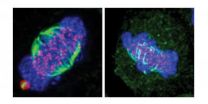Noise produces volcanic seismicity, akin to a drumbeat
Relatively small external disturbances play a crucial role in chaotic phenomena like the recent Calbuco volcanic eruption in Chile, leading to drum-beat-like seismicity
2015-05-11
(Press-News.org) Volcanoes are considered chaotic systems. They are difficult to model because the geophysical and chemical parameters in volcanic eruptions exhibit high levels of uncertainty. Now, Dmitri V. Alexandrov and colleagues from the Ural Federal University in Ekaterinburg, in the Russian Federation, have further extended an eruption model -- previously developed by other scientists -- to the friction force at work between the volcanic plug and volcanic conduit surface. The results, published in EPJ B, provide evidence that volcanic activity can be induced by external noises that would not otherwise have been predicted by the model.
Predicting when, where and how volcanic eruptions will happen is likely to remain empirical. That is, until it is possible to improve the modelling of their dynamics. The challenge of such models is that the volcanic eruption dynamics are very complex, involving simultaneous unrelated processes and offering a variety of possible scenarios.
The authors built on a previous study demonstrating the influence of noise in triggering eruptions. Namely, they assumed that, under complex friction forces, the volcano plug and conduit exhibit a previously identified mechanism, called stick-slip behaviour, which causes the volcanic plug to rise and fall in an attenuated manner. They then studied the influence of random disturbances on these dynamics. They also tested the resulting model with experimental data from the Mount St. Helen's eruption, dating back to 2004 and 2005.
Alexandrov and colleagues show that the external noise is also linked to the appearance of large-amplitude oscillations in the volcanic plug and high seismicity. An increase in noise intensity leads to drumbeat-type plug movement, exhibiting irregular periodicity dependent on noise. Such beat-type behaviour is a building block for understanding the physical mechanisms of volcanic drumbeat seismicity.
INFORMATION:
Reference:
D. V. Alexandrov, I. A. Bashkirtseva and L. B. Ryashko (2015), How a small noise generates large-amplitude oscillations in the volcanic plug and produces high seismicity, Eur. Phys. J. B 88: 106, DOI: 10.1140/epjb/e2015-60130-6
ELSE PRESS RELEASES FROM THIS DATE:
2015-05-11
Chinese scientists have reared beef rich in the beneficial fatty acids associated with fish oils. The study in Springer's journal Biotechnology Letters also highlights the scientific challenges that remain.
The team from Northwest A&F University and the National Beef Cattle Improvement Centre, both in Yangling (Shaanxi), successfully introduced a gene into foetal cells from Luxi Yellow cattle, a Chinese breed with a high beef yield. The fat1 gene, isolated from a nematode worm, codes for desaturase enzymes that are involved in the conversion of n-6 to n-3 polyunsaturated ...
2015-05-11
How much food your dining companion eats can have a big influence on how much you consume, a UNSW Australia-led study concludes.
This psychological effect, known as social modelling, leads people to eat less than they normally would if alone when their companion consumes a small amount of food.
Study lead author, Associate Professor Lenny Vartanian of the UNSW School of Psychology, says that in social situations the appropriate amount of food to eat can be unclear.
"Internal signals like hunger and feeling full can often be unreliable guides. In these situations people ...
2015-05-11
An international consortium of scientists led by a group from the University of Leicester has announced a new advance in understanding the mechanisms of cancer and how to target it more effectively with new treatments.
Two papers published in the same issue of the world-leading Journal of Cell Biology have arisen from research work led by Professor Andrew Fry at the University of Leicester. Both papers suggest that new understanding of the mechanics of cell division can reveal new targets for cancer therapy.
Professor Fry, who is Director of Research in the College ...
2015-05-11
Geoscientists have, for the first time, discovered the origins of Australia's two largest basins: Lake Eyre and the Murray-Darling Basin. The research also implies that in 30 million years' time both basins will cease to exist.
Monash University geoscientist Associate Professor Wouter Schellart, and his colleague Professor Wim Spakman from Utrecht University, have discovered how the floor of an entire ocean basin that was destroyed 70 to 50 million years ago off the North coast of New Guinea is currently located at 800-1200km depth below Central and South-eastern Australia.
Using ...
2015-05-11
New scanning methods which map the wiring of the brain could provide a valuable new tool to predict people at risk of schizophrenia, according to a new study.
Scientists have long known that the symptoms of schizophrenia are partly explained by disordered connectivity in the brain.
Now, a team of scientists from Cardiff University Brain Research Imaging Centre (CUBRIC), the Institute of Psychiatry, Psychology and Neuroscience, Kings College London and the University of Bristol, have, for the first time, used Magnetic Resonance Imaging (MRI) to identify how the ...
2015-05-11
Myopia or short-sightedness is becoming more common across Europe, according to a new study led by King's College London. The meta-analysis of findings from 15 studies by the European Eye Epidemiology Consortium found that around a quarter of the European population is short-sighted but it is nearly twice as common in younger people, with almost half (47 per cent) of the group aged between 25 and 29 years affected.
The analysis of studies covering over 60,000 people, which was published today in the journal Ophthalmology, also found a strong link between myopia and level ...
2015-05-11
New research suggests the use of hookah steam stones - commonly considered a safer alternative to cigarette smoking - could be leaving users with a dangerous, false sense of security. The findings out of the University of Cincinnati/Agilent Technologies Metallomics Center of the Americas are published this month in the Microchemical Journal.
An analysis led by Amberlie Clutterbuck, a doctoral student in the UC Department of Chemistry, found residues of toxic metals that included chromium, arsenic and cadmium following several simulated hookah/steam stones smoking scenarios.
Clutterbuck's ...
2015-05-11
Philadelphia, PA, May 11, 2015 -- Dopamine is the chemical messenger in the brain most closely associated with pleasure and reward. Recent scientific advances now shed light on precise roles for dopamine in the reward process.
A new paper published in the current issue of Biological Psychiatry implicates dopamine in a person's ability to be motivated by delayed rewards.
People like immediate reinforcement and tend to devalue rewards that are substantially delayed in time. As a result, people will often opt for smaller immediate rewards as opposed to larger delayed rewards ...
2015-05-11
Even with the best available treatments, the median survival of patients with metastatic, hormone-refractory prostate cancer is only two to three years. Driven by the need for more effective therapies for these patients, researchers at VCU Massey Cancer Center and the VCU Institute of Molecular Medicine (VIMM) have developed a unique approach that uses microscopic gas bubbles to deliver directly to the cancer a viral gene therapy in combination with an experimental drug that targets a specific gene driving the cancer's growth.
Recently published in the journal Oncotarget, ...
2015-05-11
CORVALLIS, Ore. - Scientists at Oregon State University have developed a faster, more accurate method to assess cancer risk from certain common environmental pollutants.
Researchers found that they could analyze the immediate genetic responses of the skin cells of exposed mice and apply statistical approaches to determine whether or not those cells would eventually become cancerous.
The study focused on an important class of pollutants known as polycyclic aromatic hydrocarbons, or PAHs, that commonly occur in the environment as mixtures such as diesel exhaust and cigarette ...
LAST 30 PRESS RELEASES:
[Press-News.org] Noise produces volcanic seismicity, akin to a drumbeat
Relatively small external disturbances play a crucial role in chaotic phenomena like the recent Calbuco volcanic eruption in Chile, leading to drum-beat-like seismicity



